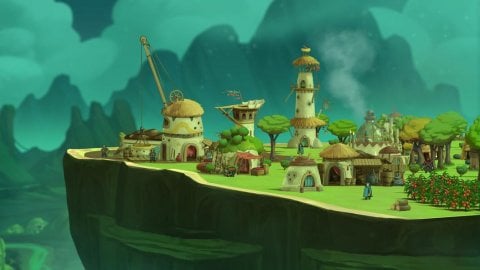
The Wandering Village, we tried a city builder inspired by Studio Ghibli
The Wandering Village
Often to break into the hearts of gamers, even those a little more disenchanted and with a few years on their shoulders, an idea is enough. It doesn't matter if it's a gameplay idea or a particular artistic inspiration, in a saturated and mature market like the current one you need something to rise above the crowd.The Swiss team of Stray Fawn Studio, for example , has found a rather interesting interpretation for its new city builder: our test of The Wandering Village, in fact, has led us into a world that seems to have come out of weight from the first films of Studio Ghibli and, among a exploration and construction of a palace, we seemed to be at the head of one of the many villages that dot the world of Laputa or Nausicaa.
A city builder sui generis
The little beast on which the village of The Wandering Village develops Let's start with the formal things: The Wandering Village is currently available on Steam at this address through the Early Access formula. In other words, the game is not yet completed, but it is already perfectly enjoyable by all those who want to trust the project by investing 25 euros. It is a rather peculiar city builder: instead of being set in a dystopian world, frozen or at war, our village will rise on the back of a huge creature, Onbu, who will walk tirelessly along the roads that cross a rather run down.Fortunately, nothing will be missing on Onbu's back: spaces are limited, but there is enough land to create fields, build a village and advance one's civilization. Our relationship with Onbu will not be one-sided: it is true that the village can thrive thanks to the natural resources it generates (the poop) or grow on its back (trees and rocks), but soon we will be able to create useful buildings to interface with. him, to feed him, heal him or to try to direct him to one of the many crossroads.
In this way the developers of Stray Fawn Studio have inserted several layers to their production. There is the initial and more superficial one that plans to make the small community that has settled on Onbu's back grow and prosper. From this point of view there are few jolts to the classic formula: we will have to navigate the management of limited resources to try to find the right balance between the production of food and the exploitation of nature.
Intertwined with the management of the village c 'is that of Onbu. Not only because exploiting certain parts of his body could upset him, but because it could be induced to generate resources (poop) with which to improve agriculture or even extract blood from his body for special fuels. Furthermore, the path he has chosen will greatly influence the economy: in the desert water production is very limited and food production will have to be remodeled accordingly.
Onbu's exploration and journey management map in The Wandering Village The last part is that of exploration: you can send teams around the world to look for resources of various kinds with which to overcome the limitations imposed by Onbu. The explorers, in fact, can return with new knowledge, but also wood, minerals and travelers, which can be integrated or rejected.
The first hours with The Wandering Village flow, therefore, in a convincing way, while progressively they include all the gameplay dynamics, how to interact with resources (watch out for the Mother Trees, don't cut them like we did!) and with Onbu. After that The Wandering Village seems to lose some momentum, with phases where little happens and one is simply waiting for the next technology or crossroads to be found. However, we are in Early Access and Stray Fawn Studio can progressively add some thickness to the more advanced phases of the campaign, also because technically The Wandering Village is already a gem.
Studio Ghiblesco
The Wandering Village graphics look like something out of a Studio Ghibli movie Maybe it's us, but in The Wandering Village we saw a lot of Studio Ghibli. The pastel colors, the design of the characters and the atmosphere that you breathe reminded us of the first works of the Japanese studio, such as Laputa - Castle in the sky, Nausicaä of the Valley of the wind or Conan. The colossus that wanders in a desert world, with poisoned areas and rural civilizations, but with a touch of futuristic technology, there seemed to be other elements of contact.Even if this were not the case, The Wandering Village remains very pleasant from to see and play, a small technical jewel, rather light to turn and with a truly spectacular zoom, which goes from the detail of the individual citizen to the global map, passing through the one that shows in good Onbu.
Lo The Wandering Village style is very pleasant The only flaw we found in our test, but we repeat, we are in Early Access, it is an interface that is not always very readable, which does not clearly indicate what needs to be done (as for example a team that is inactive) or the needs of the population.
The first impact with The Wandering Village was excellent: the style chosen by Stray Fawn Studio, the original cut given to the gameplay, the excellent technical sector and the stratifi cation of the mechanics immediately convinced us. After several hours of play we reached a point where she felt a little tired, but the game, in early access, has all the credentials to make these situations more interesting, perhaps introducing some more random events or a more insightful narrative. In any case, it is a pleasant experience, to be kept in mind.